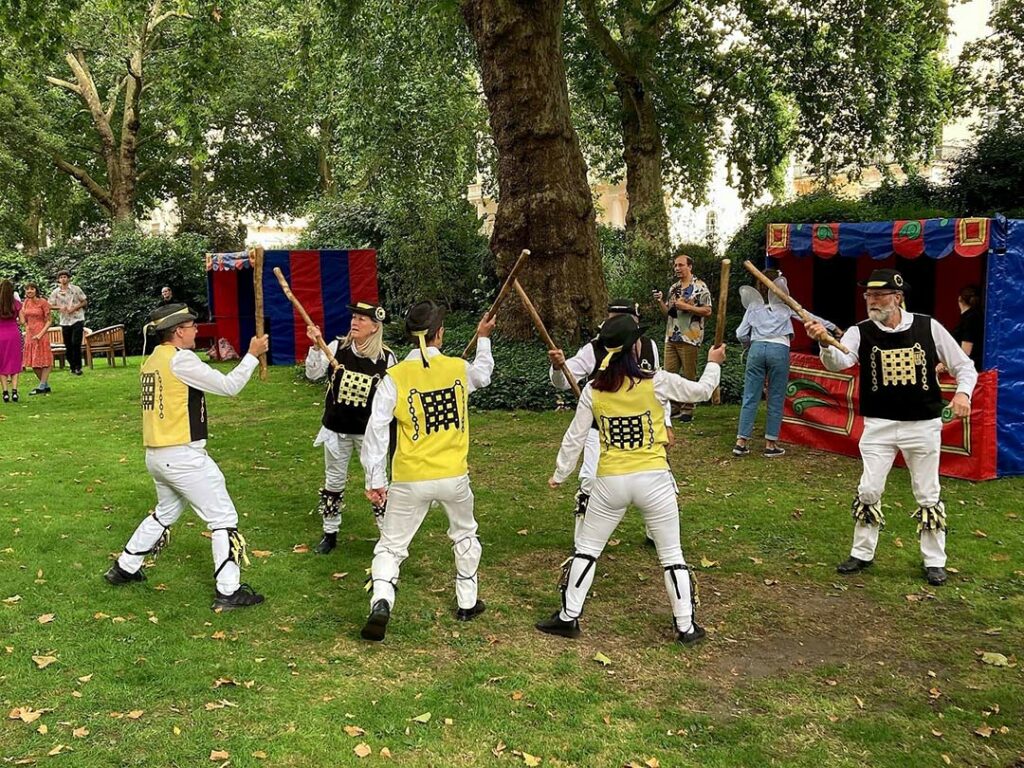Sarah Crofts, aged 68, retired from working as a university librarian nearly seven years ago. As well as dancing Morris, she is a musician who plays Anglo-concertina, mostly at sessions these days although she has played as part of a ceilidh/barn dance band in the past. She is also an organiser, with others, of the Deptford Jack in the Green which appears every year on May Day.
I would never have imagined when I started dancing that I would still be doing it forty years later. I began dancing with Dacre Morris just a year after they were founded in 1981. They were, and still are, an all-female team although they have some male musicians now. At the time, women who wanted to dance Morris formed their own teams as it was not possible to join existing all-male teams.
This great flowering of female Morris dance had started in the 1970s, sometimes with encouragement from male dancers, but often without. Times have changed and there are now many mixed teams as well as single sex teams. This change in attitude led me to join an additional Morris team, Westminster Morris, who were formed in 1953 to celebrate the coronation and voted to admit women in 2018.
I joined them in September 2019, and as everyone will know, late 2019 was a bad time to start doing anything! However, both Dacre and Westminster kept going through lockdowns via Zoom get-togethers and emerged to carry on dancing in 2021. I also attended some online workshops via Zoom facilitated by the Morris Federation, one of the three Morris umbrella organisations. (The other two are The Morris Ring and Open Morris.)
After the end of lockdowns in 2021, Westminster met for two open air practices in Green Park. This was such fun and people stopped to watch even though we were not dancing in kit or for public performance. At one point, two mounted police officers stopped by; I was a little apprehensive, but they were all smiles and they paused to watch and chat. After that it was straight into the dance season with tours in June and July in central London and a wonderful trip to Plymouth in September to dance with Plymouth Morris for the 400th anniversary celebrations of the Mayflower’s sailing, delayed from 2020.
I have always liked dancing and have had various forays into ballroom dancing, tap, lindy hop and step dancing from my twenties onwards, following the obligatory Scottish and country dancing at junior school.
What I like about Morris dance is that it’s the dance of the people. Anyone can do it and most people get it in the end. Morris is the original street entertainment, and most people enjoy watching. If they don’t, they can just walk on by. I enjoy the camaraderie – you get to dance with such a wide range of people from all backgrounds, some of whom will become your closest friends. Morris is the gateway drug to many other addictions, such as learning other traditional dance styles, playing traditional music and going to folk festivals.
Starting to dance again after the pandemic was difficult, both physically and mentally. Although we had danced at our weekly Dacre Zoom meetings, it really was not the same as dancing together at a practice and I found that much of my ability to leap fairly high off the ground had gone, but I feel satisfied that I can still leave the ground. Morris is a style of dance where, in certain steps, both feet are off the ground – a distinctive feature – and nothing looks worse than a team who are just walking rather than dancing.
An important aspect of Morris dancing is the ability to learn and remember the dances, as during the dance, you need to be thinking ahead about what you will be doing next. Returning to dancing with Dacre was relatively easy as I had been doing the dances for so long, however dancing with Westminster was a different matter. Because I had been dancing with them for a relatively short time before all the lockdowns, the dances were not embedded in my mind, and I sometimes had the awful feeling of standing up to do a dance and wondering how it started!
I think learning something new later in life can take longer, but it is possible.
The Westminster dances are very precise; you need to be on the correct foot, facing the correct way, in the correct position in the set, otherwise the foreman (teacher) will soon tell you – as will the rest of the team. When I started with Westminster, I found that there seemed to be a queue of people waiting to give me notes at the end of each dance! I am quite pleased now that I am picked up on only one or two points or sometimes none at all.
One of my tricks for trying to embed the dances is to rehearse them mentally. I often do this when I go to bed, and I often drop off before I am halfway through the dance. My feeling is that if you can do a dance in your head, you can do it in reality although, of course, physical practice is needed as well.
I sometimes wonder how it must be for people coming to Morris dance later in life. I have noticed over the years that some dancers, who have started later in life, make an effort to learn the dances even though they cannot physically jump as high or cover the ground as quickly as others and this more than compensates for any lack of physical ability.
Ageing obviously affects the ability to dance but I believe that it is still possible to do the correct stepping and hand movements and be in the right place at the right time without leaping quite as high as you once could. Warming up before dancing is very important as is warming down afterwards. This is often overlooked but is well worth doing as I discovered a couple of months ago when I experienced very painful cramp in my legs after Morris practice.
Whatever age you are, you may still be able to participate in Morris in some way. The foreman or teacher needs to have a good knowledge of the dances and be able to explain them to those learning – it is always possible to ask another dancer to demonstrate something. Dancers who play an instrument may decide to play for the dancing; one of my closest friends, who died ten years ago, was an excellent Morris musician despite not being able to dance after he broke a leg very badly in his twenties.
Best of all, you can always watch others dancing while enjoying a beer or two!
Sarah Crofts
You can find Dacre Morris here:
@DacreMorrisLewisham on Facebook
@DacreMorris on Twitter
You can find Westminster Morris here:
@morrisdancers on Twitter and Facebook
You can find Morris Federation UK here:
@MorrisFed.org.uk on Facebook
@MorrisFed on Twitter

Our monthly flash theme for April was Dance and Neurodivergence
In April we celebrate both International Dance Day and World Autism Awareness Day and we would love to read your flash submissions in honour of either or both of these themes. Would you like to tell us something about your experience of being an older person who loves to dance, learned to dance or teaches dance? Has dance had a positive impact on your life and health? Are you an older person with an experience of neurodivergence? We’d be honoured to hear about your experience of autism or neurodivergence intersects with your creativity, or about getting a diagnosis later in life.
Entries will be accepted until midnight on April 30th and flash submissions can take the form of a poem, short story or flash memoir. The winning entry will be chosen by the Autumn Voices staff team and the winner will receive a book prize.



